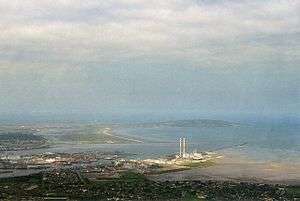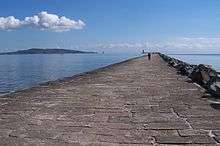Poolbeg
Poolbeg (Irish: Poll Beag) is a peninsula extending from Ringsend, Dublin, into Dublin Bay.

Overview
It is home to the Great South Wall, Poolbeg Lighthouse, Irishtown Nature Park, the southern part of Dublin Port, an energy-from-waste facility, and Dublin's former main power station, including two landmark chimneys, which at just over 207m are Dublin's tallest structures.
Poolbeg Chimneys

The thermal station chimneys at Poolbeg Generating Station are among the tallest structures in Ireland and are visible from most of Dublin city. Number 1 chimney is 207.48m (680 ft 9in) high, while Number 2 chimney is 207.8m (681 ft 9in) high. The chimneys are featured prominently in the video for the song "Pride (In The Name Of Love)" by U2. Dublin City Councillor and historian Dermot Lacey began a process to list the chimneys for preservation to safeguard their future after the Station was to close in 2010.[1][2] This was later refused by the Council Planning Department.
.jpg)
They were subsequently listed as protected structures in July 2014.[3]
21st century plans
New residential area and bridge
The Poolbeg West development consists of 34 hectares of land which has been designated for fast-track planning permission for the construction of nine storey apartment blocks and up to 100,000sqm of commercial and retail space, including 3,000 homes and commercial space for 8,000 workers.[4]
In June 2016 Dublin City Council announced that it would fast-track construction of a €30 million bridge linking Dublin’s south Docklands with the planned new “urban quarter” on the Poolbeg peninsula.[5]
References
- Plea to save iconic twin stacks. Irish Independent 2007-07-07.
- Poolbeg's chimneys puff their last plumes SADNESS: Landmark now looks doomed despite preservation bid. Evening Herald, 2010-03-31.
- Carbery, Genevieve. "Lit up Poolbeg stacks could be 'as beautiful as Eiffel Tower'". The Irish Times.
- Stephen McDermott (January 25, 2017). "New town with 3000 homes planned for Poolbeg". Dublin Live.
- Olivia Kelly (July 11, 2016). "New bridge will connect Poolbeg peninsula to the docklands". The Irish Times.